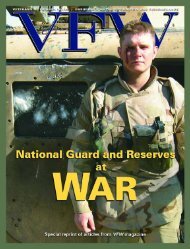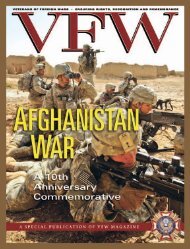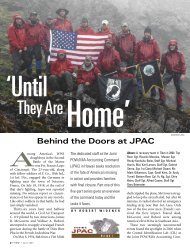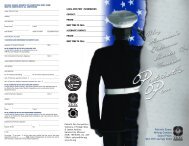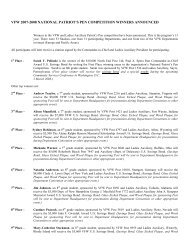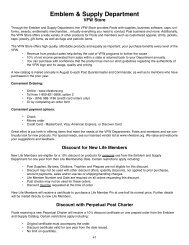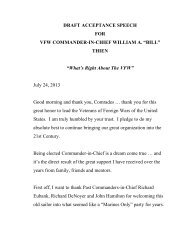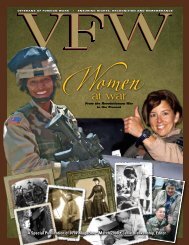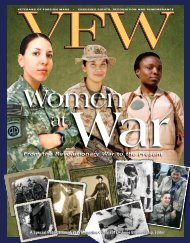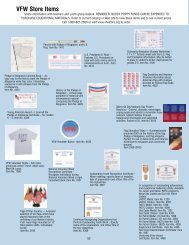2006 VFW Magazine - Veterans of Foreign Wars
2006 VFW Magazine - Veterans of Foreign Wars
2006 VFW Magazine - Veterans of Foreign Wars
You also want an ePaper? Increase the reach of your titles
YUMPU automatically turns print PDFs into web optimized ePapers that Google loves.
issuesupfront<br />
Succeeding in the Civilian Job Market<br />
Finding jobs for discharged vets and protecting reservist re-employment rights is <strong>of</strong> utmost importance during wartime.<br />
by Shannon Hanson<br />
6 • WWW.<strong>VFW</strong>.ORG • © <strong>2006</strong> <strong>VFW</strong> <strong>Magazine</strong><br />
Among the multitude <strong>of</strong> issues<br />
faced by veterans from Iraq and<br />
Afghanistan upon their return<br />
home is the pressing problem <strong>of</strong><br />
employment. Discharged vets have to<br />
find ways to transfer their military job<br />
skills into the civilian world; reservists<br />
and National Guardsmen can face difficulties<br />
returning to their civilian jobs.<br />
Legislation has been passed and programs<br />
created to help these vets. But<br />
according to the Department <strong>of</strong> Labor,<br />
the current unemployment rate among<br />
young veterans (20-24) is 15.8%, twice<br />
the rate <strong>of</strong> non-veterans the same age.<br />
Senate VA Committee Chairman<br />
Larry Craig (R-Idaho) said, “This trend<br />
<strong>of</strong> rising unemployment suggests to me<br />
that we, as a nation, must do more to<br />
help these young veterans succeed in<br />
the civilian job market.”<br />
The government’s newest program,<br />
VA initiative Fulfilling the Commitment—Coming<br />
Home to Work, aims to<br />
make it easier for recent vets to access<br />
existing job-search resources, and to<br />
encourage employers to look at veterans<br />
as a desirable employee base. VA<br />
Secretary Jim Nicholson also hopes to<br />
create a job database and a network <strong>of</strong><br />
private-sector companies interested in<br />
veteran-employees.<br />
Upon its creation by the Jobs for<br />
<strong>Veterans</strong> Act (P.L. 107-288), the president’s<br />
National Hire <strong>Veterans</strong> Committee<br />
developed the program Hire Vets<br />
First (www.hirevetsfirst.gov). This Internet<br />
resource includes an area for<br />
employers, with reasons to hire vets,<br />
skills translators and testimonials; and<br />
an area for vets, to search for jobs and get<br />
resumé assistance and transition advice.<br />
The Transition Assistance Program<br />
(TAP), begun in 1990, is another tool<br />
available to vets that a June 2005 Government<br />
Accountability Office report recommended<br />
making mandatory. It <strong>of</strong>fers<br />
three-day workshops at select military<br />
installations that provide information on<br />
job searches, career decision-making, job<br />
market conditions, resumés and cover<br />
letters, interviewing skills and current<br />
veterans benefits.<br />
Cody Green attended a TAP workshop<br />
in Norfolk, Va., after leaving the<br />
Navy in December 2004. “A lot <strong>of</strong> people<br />
told me I would have a hard time<br />
finding a job after I got out,” he said.<br />
Employment Stats 2004<br />
• 43,262 vets hired by federal<br />
agencies<br />
• 19% <strong>of</strong> federal agency new hires<br />
were vets<br />
• 454,000 vets in federal<br />
workforce (25%)<br />
• 9.4% <strong>of</strong> private sector workforce<br />
were vets<br />
• 87,390 disabled vets in federal<br />
workforce (up 11% from<br />
previous year)<br />
• 15.8% unemployment rate for<br />
young vets (age 20-24)<br />
Source: Department <strong>of</strong> Labor and Office<br />
<strong>of</strong> Personnel Management<br />
“But I was under the impression, being<br />
a veteran at a time <strong>of</strong> war, I would be<br />
able to find a job pretty quickly.” Green<br />
got a job in August 2005.<br />
<strong>VFW</strong> also works directly with a job<br />
service provider. VetJobs.com (www.vetjobs.com)<br />
is a full-service job- and<br />
resumé-posting Web site.<br />
Special programs for wounded or<br />
disabled vets also are available. Disabled<br />
TAP workshops include the regular<br />
three-day workshop plus individual<br />
instruction addressing the special needs<br />
<strong>of</strong> service-connected disabled vets.<br />
In 2005, the Labor and Defense<br />
departments launched the Recovery<br />
and Employment Assistance Lifelines<br />
(REALifelines) initiative, a personalized<br />
assistance network that trains seriously<br />
wounded GIs unable to return to active<br />
duty for a civilian career. Representatives<br />
are stationed at Walter Reed Army<br />
Medical Center, Bethesda National Naval<br />
Medical Center, Ft. Lewis, Wash., and Ft.<br />
Sam Houston in San Antonio.<br />
When it comes to government jobs,<br />
veterans preference is in place to grant<br />
extra points on civil service exams. In<br />
January, the Office <strong>of</strong> Personnel Management<br />
announced the inclusion <strong>of</strong><br />
Afghanistan and Iraq Campaign Medal<br />
recipients’ entitlement to preference in<br />
federal hiring.<br />
But the key to veterans employment<br />
could be in the private sector. According<br />
to Wesley Poriotis <strong>of</strong> the Center for<br />
Military and Private Sector Initiatives,<br />
“To find jobs in the private sector, you<br />
need to engage persons with private-sector<br />
experience to fund these jobs and<br />
then connect veterans to those jobs.”<br />
Programs that accomplish this are sure<br />
to come down the pike soon.<br />
USERRA Protects Vets<br />
Members <strong>of</strong> the Reserves and National<br />
Guard face their own unique challenges<br />
when they return home from war. The<br />
Uniformed Services Employment and Reemployment<br />
Rights Act (USERRA) outlines<br />
the rights and responsibilities <strong>of</strong><br />
returning Reserve and Guard members,<br />
and their employers. New rules clarifying<br />
USERRA went into effect Jan. 18, the<br />
first explanation <strong>of</strong> the act since the law<br />
was enacted in 1994. A one-page poster<br />
released in December and available on<br />
the Web site www.dol.gov/vets outlines<br />
the new regulations.



